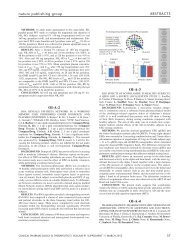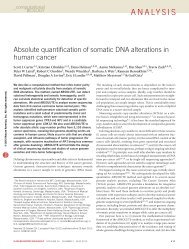open access: Nature Reviews: Key Advances in Medicine
open access: Nature Reviews: Key Advances in Medicine
open access: Nature Reviews: Key Advances in Medicine
Create successful ePaper yourself
Turn your PDF publications into a flip-book with our unique Google optimized e-Paper software.
NEPHROLOGY<br />
<strong>in</strong>flammation <strong>in</strong> hemodialysis patients. J. Am.<br />
Soc. Nephrol. 22, 437–442 (2011).<br />
4. Baigent, C. et al. The effects of lower<strong>in</strong>g LDL<br />
cholesterol with simvastat<strong>in</strong> plus ezetimibe <strong>in</strong><br />
patients with chronic kidney disease (Study of<br />
Heart and Renal Protection): a randomised<br />
placebo-controlled trial. Lancet 377,<br />
2181–2192 (2011).<br />
5. Holdaas, H. et al. Rosuvastat<strong>in</strong> <strong>in</strong> diabetic<br />
hemodialysis patients. J. Am. Soc. Nephrol. 22,<br />
1335–1341 (2011).<br />
6. W<strong>in</strong>kelmayer, W. C., Patrick, A. R., Liu, J.,<br />
Brookhart, M. A. & Setoguchi, S. The <strong>in</strong>creas<strong>in</strong>g<br />
prevalence of atrial fibrillation among<br />
hemodialysis patients. J. Am. Soc. Nephrol. 22,<br />
349–357 (2011).<br />
7. W<strong>in</strong>kelmayer, W. C., Liu, J., Setoguchi, S. &<br />
Choudhry, N. K. Effectiveness and safety of<br />
warfar<strong>in</strong> <strong>in</strong>itiation <strong>in</strong> older hemodialysis<br />
patients with <strong>in</strong>cident atrial fibrillation. Cl<strong>in</strong>. J.<br />
Am. Soc. Nephrol. http://dx.doi.org/10.2215/<br />
CJN.04550511.<br />
8. Granger, C. B. et al. Apixaban versus warfar<strong>in</strong> <strong>in</strong><br />
patients with atrial fibrillation. N. Engl. J. Med.<br />
365, 981–992 (2011).<br />
9. Eknoyan, G. et al. Effect of dialysis dose and<br />
membrane flux <strong>in</strong> ma<strong>in</strong>tenance hemodialysis.<br />
N. Engl. J. Med. 347, 2010–2019 (2002).<br />
10. Chertow, G. M. et al. In-center hemodialysis<br />
six times per week versus three times per<br />
week. N. Engl. J. Med. 363, 2287–2300<br />
(2010).<br />
TRANSPLANTATION IN 2011<br />
New agents, new ideas and new<br />
hope<br />
Titte R. Sr<strong>in</strong>ivas and Bruce Kaplan<br />
The past year was marked by several excellent studies that represent<br />
important therapeutic advances <strong>in</strong> kidney transplantation or that further<br />
our understand<strong>in</strong>g of the genetic basis of chronic allograft dysfunction,<br />
cl<strong>in</strong>ical tolerance and outcomes of kidney transplantation.<br />
Sr<strong>in</strong>ivas, T. R. & Kaplan, B. Nat. Rev. Nephrol. 8, 74–75 (2012); published onl<strong>in</strong>e 20 December 2011;<br />
doi:10.1038/nrneph.2011.215<br />
The year 2011 was marked by the addition<br />
of an important alternative to calc<strong>in</strong>eur<strong>in</strong><br />
<strong>in</strong>hibitors for immuno suppression<br />
<strong>in</strong> kidney transplantation. Calc<strong>in</strong>eur<strong>in</strong><br />
<strong>in</strong>hibitor-based comb<strong>in</strong>a tions are the most<br />
frequently utilized immuno suppressive<br />
regimens <strong>in</strong> kidney transplantation, but<br />
they carry a metabolic burden and may<br />
be associated with both short-term and<br />
possibly progressive dim<strong>in</strong>ution <strong>in</strong> graft<br />
function. Belatacept is a costimulation<br />
blocker that b<strong>in</strong>ds to CD80 and CD86<br />
on antigen- present<strong>in</strong>g cells and provides<br />
<strong>Key</strong> advances<br />
■ 3-year follow-up of BENEFIT demonstrates<br />
that belatacept provides superior renal<br />
function outcomes to ciclospor<strong>in</strong> 3<br />
■ Sensitized patients treated with a<br />
desensitization regimen have better<br />
survival than patients on dialysis<br />
or sensitized patients who undergo<br />
compatible transplantation 4<br />
■ Discovery of APOL1 variants <strong>in</strong> African<br />
Americans po<strong>in</strong>ts to a biological<br />
<strong>in</strong>fluence rather than race underly<strong>in</strong>g<br />
transplantation outcomes 6<br />
■ Increased cold ischemia times of<br />
extended criteria donor kidneys are<br />
associated with delayed graft function,<br />
but do not affect graft survival 10<br />
effective immuno suppression while be<strong>in</strong>g<br />
devoid of renal and nonrenal metabolic<br />
adverse effects. 1 A phase III study of<br />
belatacept (BENEFIT) published <strong>in</strong> 2010<br />
reported superior renal function and an<br />
improved cardiovascular and metabolic<br />
risk profile compared with a ciclospor<strong>in</strong>based<br />
regimen. 2 In this trial, 686 de novo<br />
kidney transplant recipients (of liv<strong>in</strong>g and<br />
standard criteria deceased donor kidneys)<br />
were randomly assigned to more-<strong>in</strong>tensive<br />
or less-<strong>in</strong>tensive belatacept regimens or to<br />
ciclospor<strong>in</strong>. All patients received basiliximab<br />
<strong>in</strong>duction therapy, mycophenolate<br />
mofetil and corticosteroids. Equivalent<br />
rates of graft and patient survival were<br />
noted despite an <strong>in</strong>creased frequency and<br />
severity of early rejection episodes and<br />
<strong>in</strong>creased frequency of post-transplant<br />
lympho proliferative disorder associated<br />
with belatacept. 2<br />
V<strong>in</strong>centi et al. have now reported on the<br />
efficacy and safety of belatacept at 3 years<br />
post-transplantation <strong>in</strong> the BENEFIT<br />
study. 3 Graft survival was equivalent across<br />
all regimens. At year 3 post- transplantation,<br />
the mean estimated glomerular filtration<br />
rate (eGFR) was 21 ml/m<strong>in</strong>/1.73 m 2 higher<br />
<strong>in</strong> the belatacept groups than <strong>in</strong> the ciclospor<strong>in</strong><br />
group. More importantly, from<br />
month 3 through to month 36, the slope<br />
of eGFR <strong>in</strong> the belatacept groups averaged<br />
1.1 ml/m<strong>in</strong>/1.73 m 2 per year versus<br />
–2.0 ml/m<strong>in</strong>/1.73 m 2 per year with ciclospor<strong>in</strong>.<br />
Neither a significant <strong>in</strong>crease <strong>in</strong><br />
acute rejection episodes nor new cases of<br />
post-transplant lymphoproliferative disorder<br />
after 18 months post-transplantation<br />
were observed. 3 Taken together, these f<strong>in</strong>d<strong>in</strong>gs<br />
are <strong>in</strong>deed gratify<strong>in</strong>g and represent<br />
the emergence of a non-nephrotoxic and<br />
efficacious immunosuppressive regimen<br />
<strong>in</strong> renal transplantation. This study also<br />
demon strated a disconnect between rejection<br />
rates and graft survival and function,<br />
which either reflects short follow-up or<br />
reasons that prompt reconsideration of<br />
the relationship between classic T-cellmediated<br />
rejection and outcomes. Although<br />
<strong>in</strong>itial results from BENEFIT are promis<strong>in</strong>g,<br />
their generalizability to cl<strong>in</strong>ical practice at<br />
large will depend on a paradigm shift from<br />
oral ma<strong>in</strong>tenance therapy to <strong>in</strong>fusion-based<br />
therapy. As such, whether the promis<strong>in</strong>g<br />
<strong>in</strong>itial results are susta<strong>in</strong>able on logistical<br />
and economic grounds needs further study.<br />
Sensitized transplant candidates have<br />
prolonged wait<strong>in</strong>g times, a reduced<br />
transplanta tion rate and an <strong>in</strong>creased rate<br />
of death compared with nonsensitized<br />
candidates. Although numerous centers<br />
report successful utilization of desensitization<br />
regimens <strong>in</strong> renal transplantation,<br />
they are plagued by the absence of suitable<br />
control groups. Montgomery et al. compared<br />
outcomes <strong>in</strong> 211 HLA-sensitized live<br />
donor kidney transplant recipients treated<br />
with low-dose <strong>in</strong>tra venous immunoglobul<strong>in</strong><br />
and plasma pheresis with that of<br />
two matched control groups drawn from<br />
the United Network for Organ Shar<strong>in</strong>g<br />
kidney transplant wait<strong>in</strong>g list who either<br />
rema<strong>in</strong>ed on dialysis (dialysis- only group)<br />
or who were dialyzed or underwent<br />
HLA-compatible renal transplantation<br />
(dialysis-or- transplantation group). 4 In<br />
the desensitized group, estimates of patient<br />
survival were 90.6%, 85.7% and 80.6% at 1,<br />
3 and 5 years, respectively, versus 91.1%,<br />
67.2% and 51.5% <strong>in</strong> the dialysis-only<br />
group and 93.1%, 77.0% and 65.6% <strong>in</strong> the<br />
dialysis-or-transplantation group (overall<br />
P








